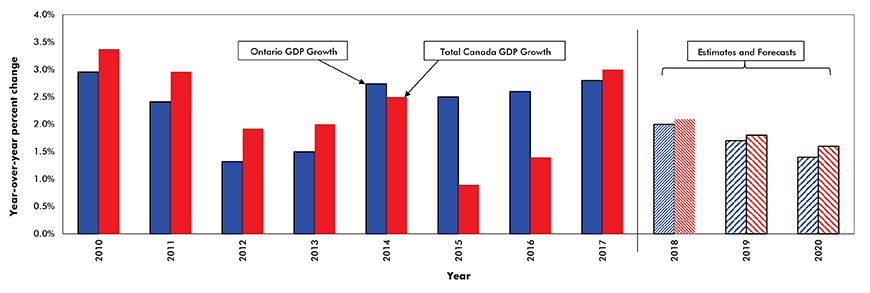While the Ontario economy is definitely expanding as it crosses the threshold into 2019, it is doing so at a more measured pace than it exhibited in the first half of the year just ended.
This more moderate pattern of growth appears to be the result of two factors. First, as noted in Snapshot #24 titled, “We are curbing our enthusiasm about Global, U.S. and Canadian economic prospects in 2019”, several key leading indicators of global economic activity, and more significantly of the U.S. economy (because it accounts for 80% of the province’s exports), have been moving lower over the past six months.
While the level of U.S./Global economic activity appears to have peaked, the prospects for the province’s exports remain positive fuelled by our southern neighbour’s economy, which is continuing to expand at a healthy pace. Also, although tariffs on our exports of steel and aluminum will hobble those two major industries, the recent successful negotiation of the U.S.-Mexico-Canada trade agreement removes a major source of uncertainty overshadowing the outlook for Ontario’s exports of manufactured goods over the next several years.
Second, after expanding above potential for the past four years, the province appears to be operating close to or at full capacity as it heads into 2019. The fact that the province’s unemployment rate is close to an 18-year low while the Canadian Federation of Independent Business has counted 168,000 jobs sitting vacant for at least four months (a 14-year high) is a clear indication that private sector employers are facing severe labour shortages. Industries with the highest job vacancy rates include retail, construction, hospitality, and manufacturing. It is worth noting that not all Ontarians are experiencing this surge in labour demand. Over the past 12 months, total employment among individuals aged 15 to 24 has fallen by 52,300, suggesting that higher minimum wages are discouraging firms from hiring younger less experienced staff.
Consistent with many of the province’s industries bumping up against their capacity ceilings, business non-residential capital spending in the first half of the year rose by 11% y/y, well ahead of the 2% y/y drop it posted in the first half of 2017.
Major projects currently underway in the province include the Darlington Nuclear Refurbishment, the Eglinton Crosstown LRT, the Spadina Subway and the life-expectancy extension of the Bruce Power Plant.
Major projects which should underpin capital spending going forward include the Yonge St. Subway Relief Line, Ottawa Civic Hospital, Nova Chemicals’ St. Clair Polyethylene Plant and the Gordie Howe Bridge.
Housing demand in the province continues to be depressed by lingering effects of the mortgage stress test introduced by the federal government at the beginning of last year. Late in 2018, existing home sales were down by 14.5% year to date and home prices had fallen by 2.9% year over year .
Not surprisingly, housing starts were down by 1.4% through November 2018 compared to a 9% increase in the first eleven months of 2017. The effects of the mortgage stress test are likely to continue to be an impediment to all home buyers and particularly to those planning to purchase their first home. However, the results of the annual RBC Homeownership Poll suggest that a significant percentage of Canadians (32%) and a similar percentage of Ontarians (33%) are planning to buy a home (new or existing) in the next two years. These plans have been accelerated by increasing concern about the potential impact of higher mortgage rates on home affordability.
A second factor likely to support housing demand in the province over the near term is an unprecedented inflow of migrants from outside the country and from other provinces. While these positive factors will underpin housing demand in 2019 and 2020, we expect housing starts in the province to decline from an estimated 79,000 units in 2018 to 72,000 in 2019 due to a combination of higher interest rates and the impact of higher prices on home affordability in the Greater Toronto Area, home to half the province’s population.
Despite the prospect that the province will continue to benefit from the sustained expansion of its southern neighbour, growth in 2019 will be held in check by the above-mentioned very tight labour market that is likely to exert a drag on both consumer spending and housing demand.
In addition, we expect the provincial government will scale back its spending in an effort to shrink a much higher than previously estimated budgetary deficit. Finally, given that its manufacturing and construction sectors are both energy intensive, the province is very exposed to the negative impact of the federal government’s proposed carbon tax.
Real* Gross Domestic Product (GDP) Growth — Ontario vs Canada











Recent Comments
comments for this post are closed